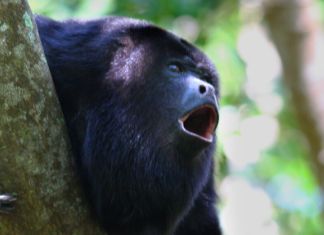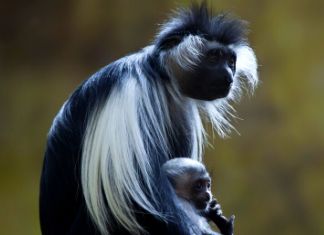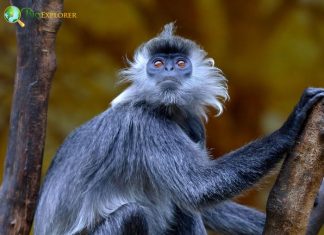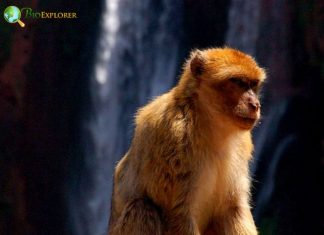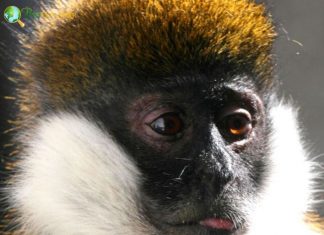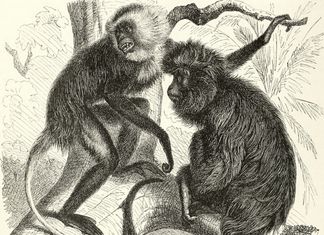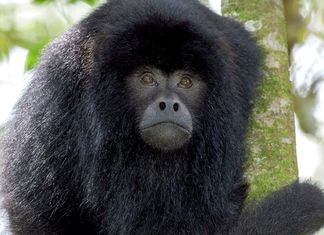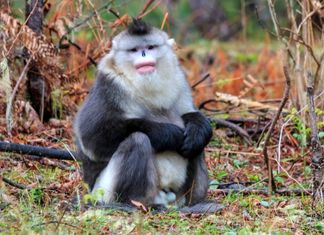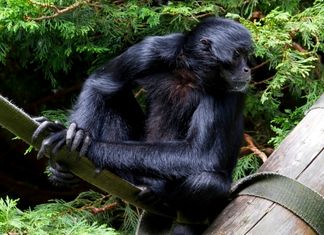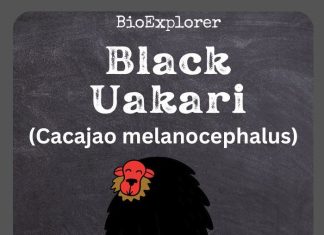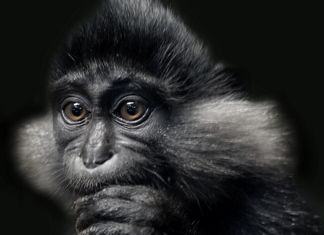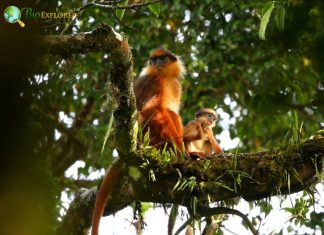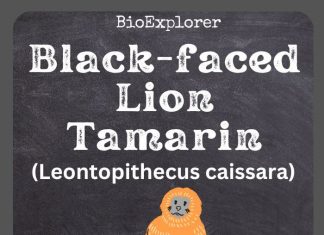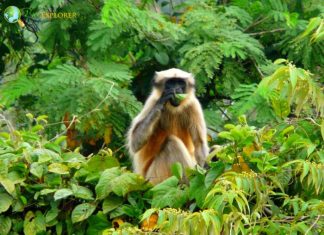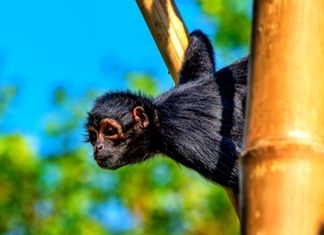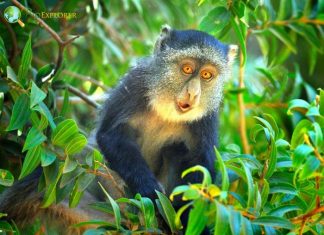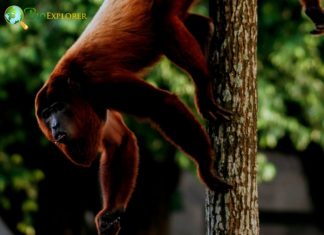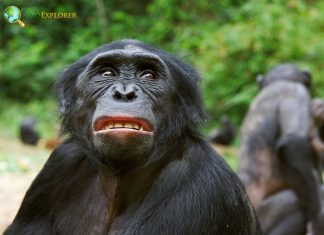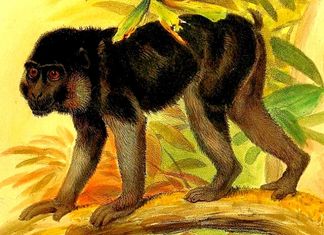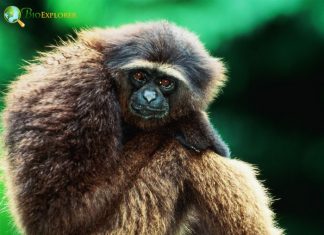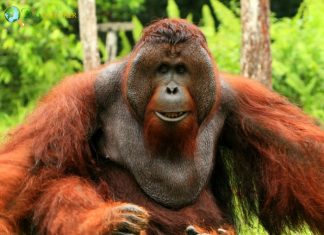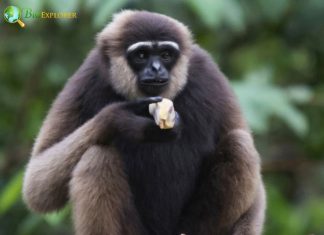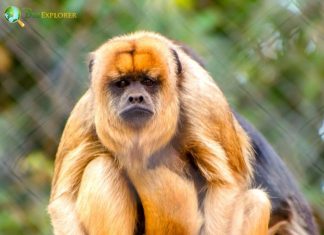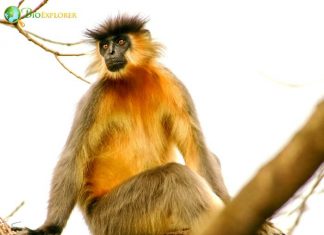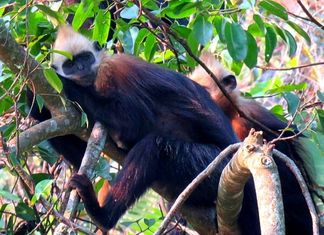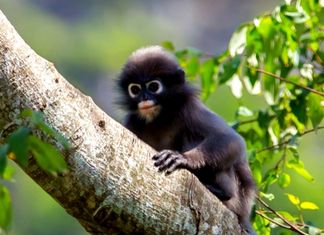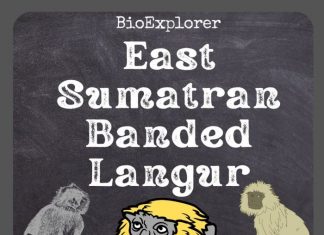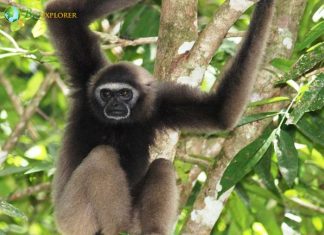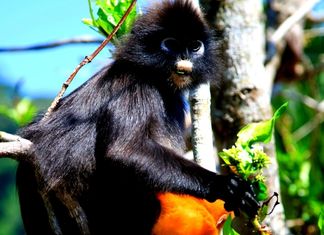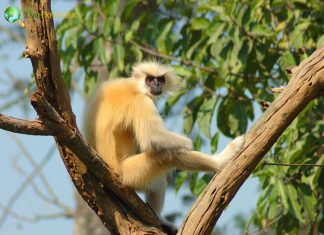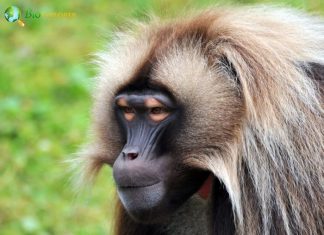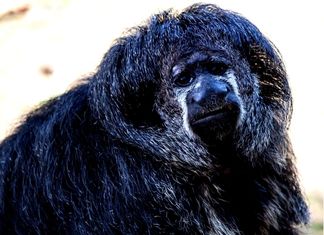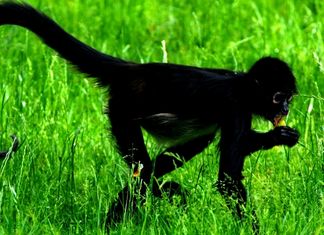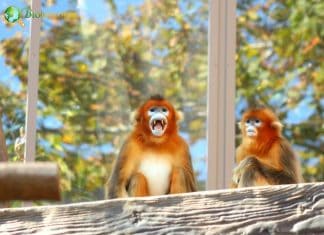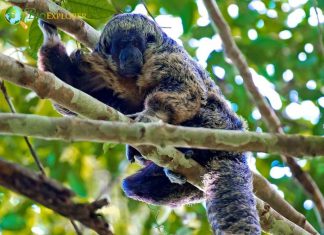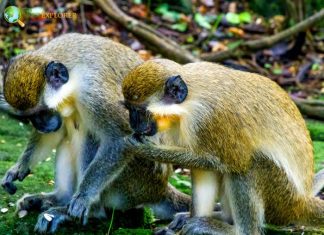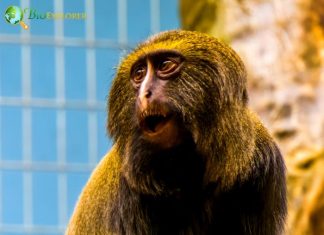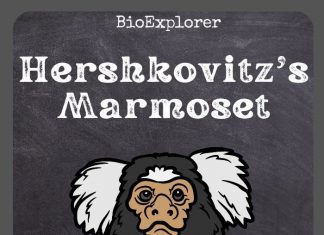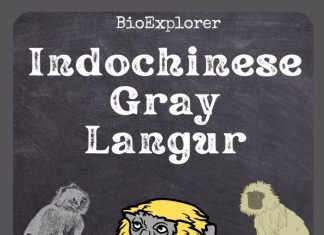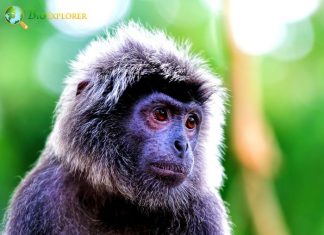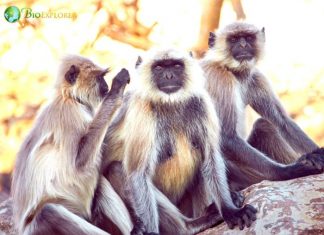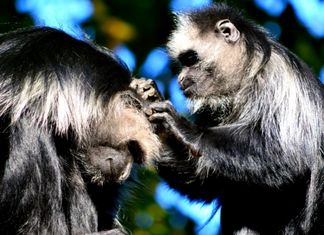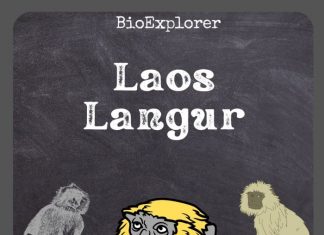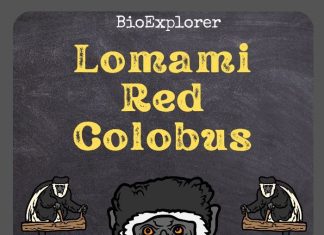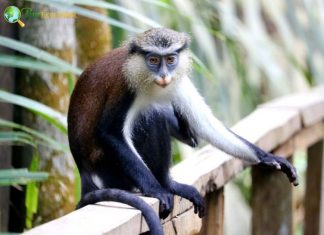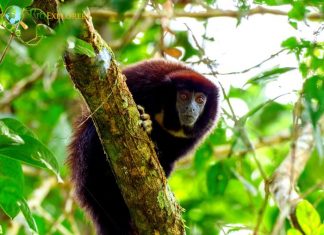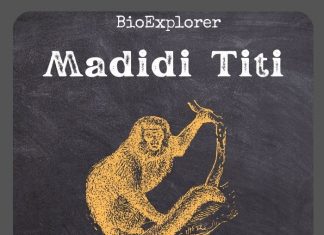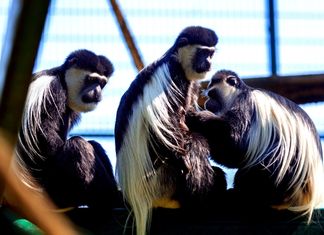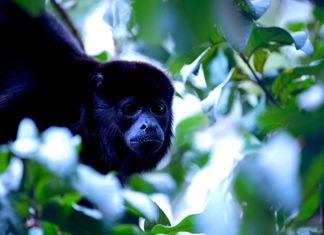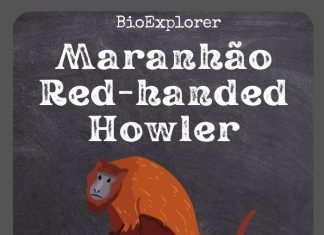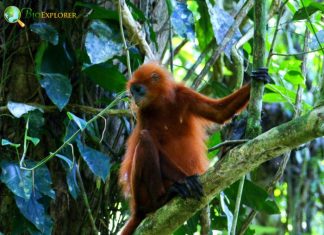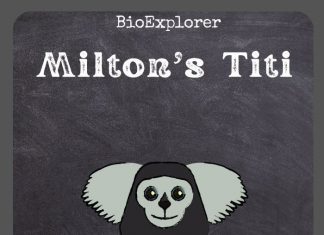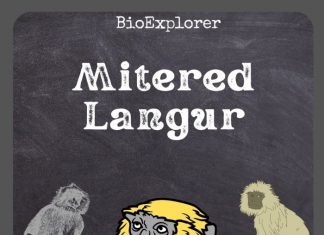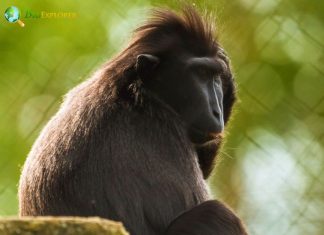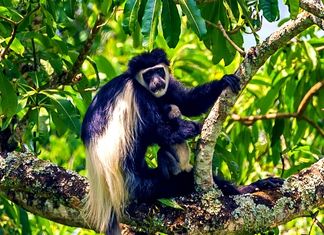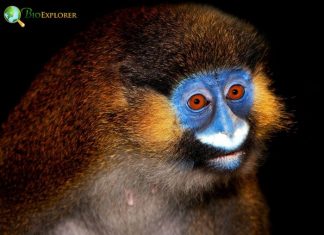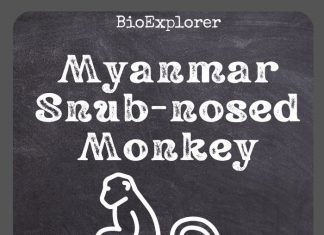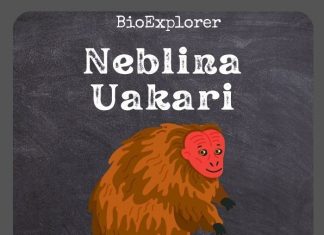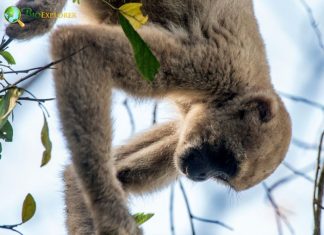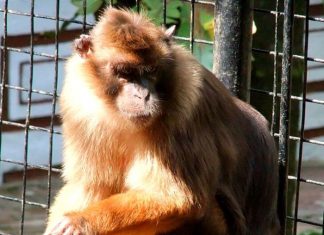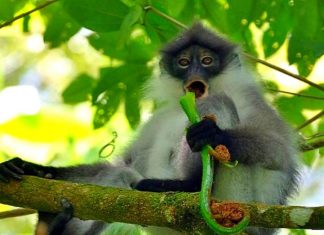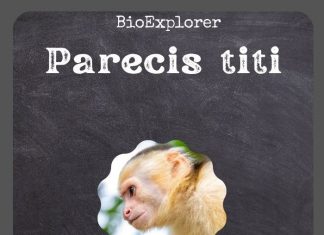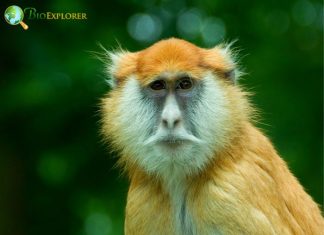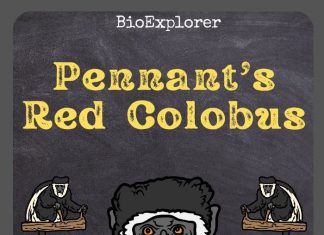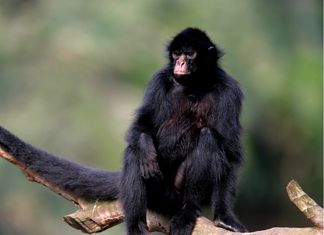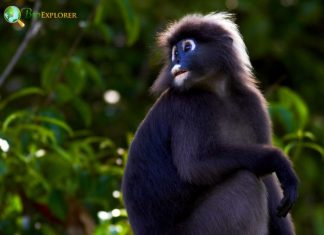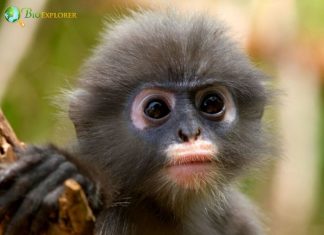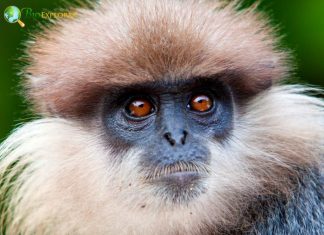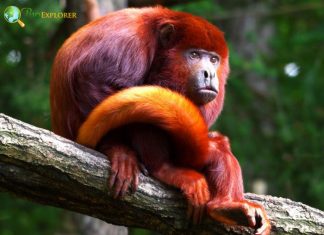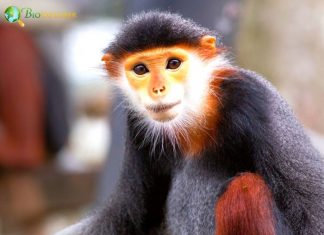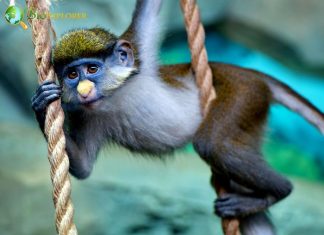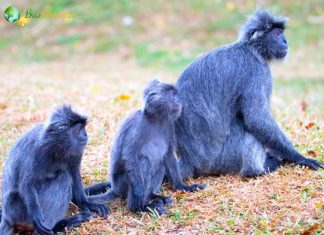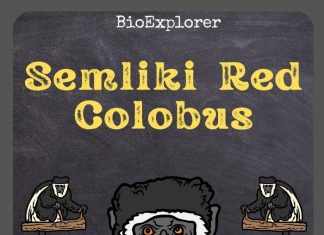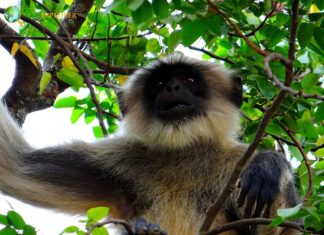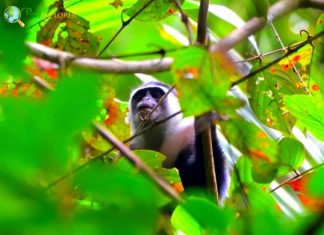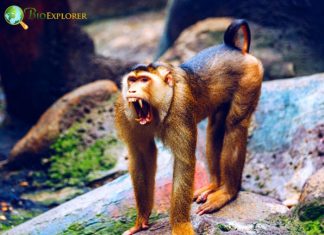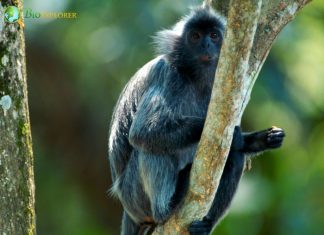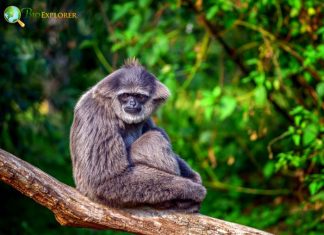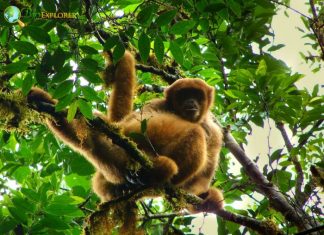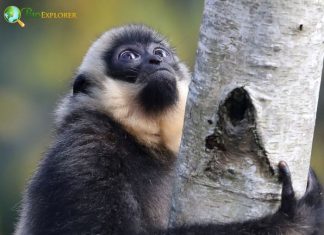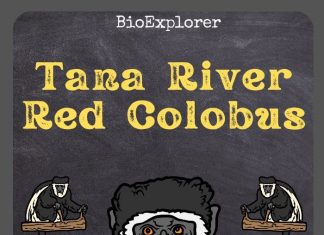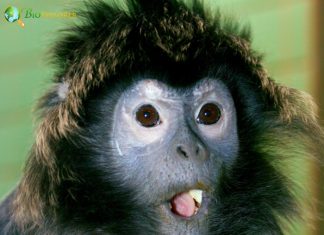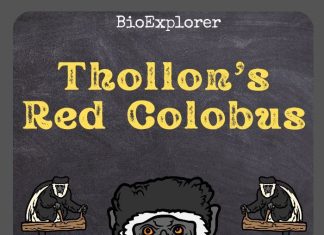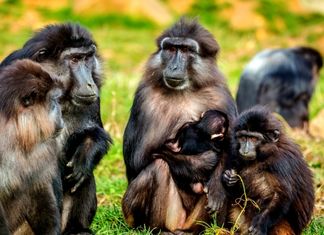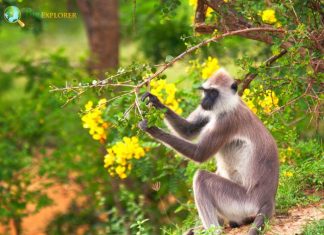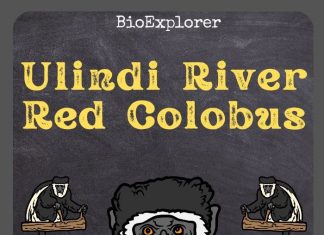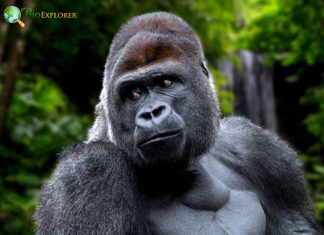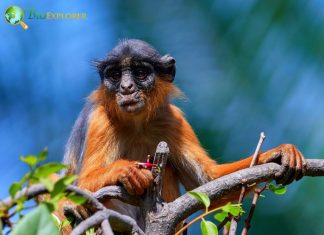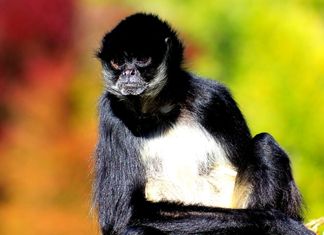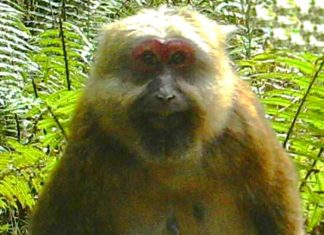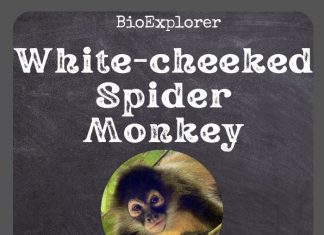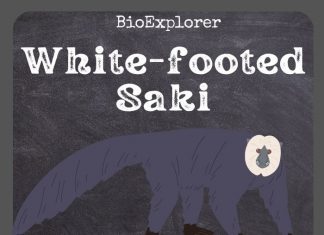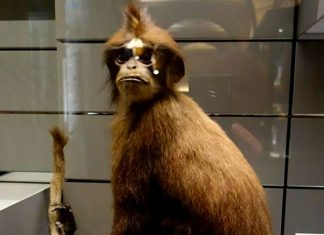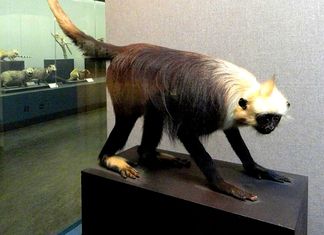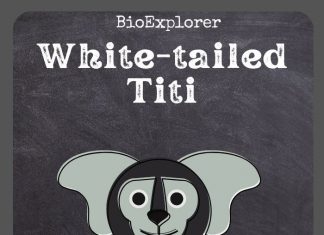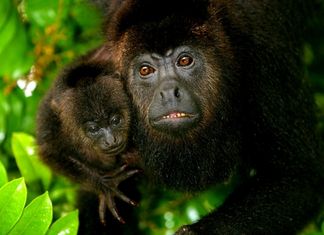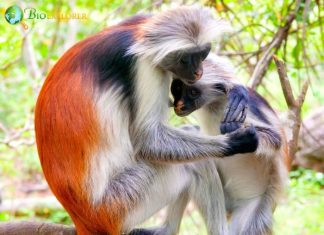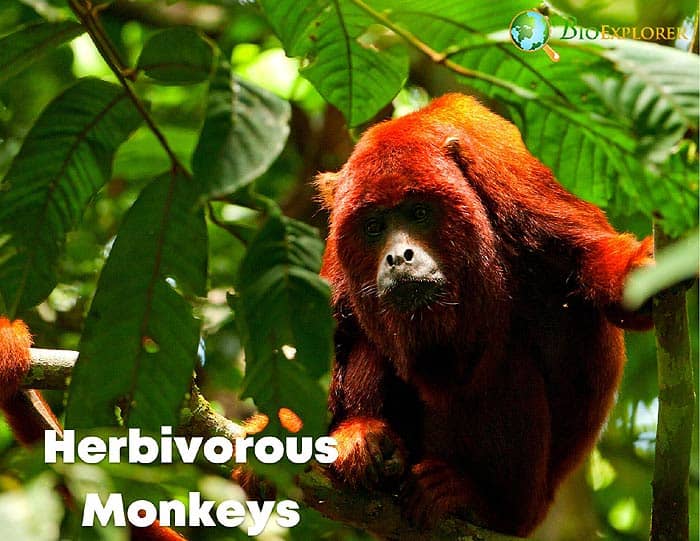
Herbivore monkeys dine solely on plant matters, including leaves, fruits, stems, nuts, and flowers. Here is the full listing of all herbivore Old-world and New-world monkeys, including Bolivian Red Howler, Atlantic Titi, Javan Surili, Mount Kilimanjaro Guereza, and more.
Herbivorous Monkeys
Amazon Black Howler
Species Name: Alouatta nigerrimaDiet: Herbivorous
Amazon Black Howler is a New World tropical arboreal characterized by densely furry, prehensile tails, all-black faces, a stocky build, relatively large size, and loud howls. According to researchers, its howl sounds like a strong wind blowing through a tunnel can be heard more than two miles away.
Angolan Colobus
Species Name: Colobus angolensisDiet: Herbivorous
The Angolan Colobus is a conspicuously-patterned monkey with a very long tail that helps it maintain its balance as it moves quickly through the trees. Although the species is named after Angola, it's rare in this country.
Annamese Silvered Langur
Species Name: Trachypithecus margaritaDiet: Herbivorous
The Annamese langur is another Old-World monkey in the subfamily Colobinae. Annamese langurs are covered in thick, gray fur. They have dark faces, and the space around the eyes is pale and forms a ring, often in the flesh. Trachypithecus margarita is a monotypic species as it has no subspecies.
Arunachal Macaque
Species Name: Macaca munzalaDiet: Herbivorous
The Arunachal macaque is a comparatively sizeable brown primate with a relatively short tail. Arunachal macaques were first classified into Cercopithecidae's taxonomy in 2005 by primatologists Madhusudan and Mishra.
Bale Monkey
Species Name: Chlorocebus djamdjamensisDiet: Herbivorous
The Bale monkey, also called the Bale Mountain Vervet, is an endangered, forest-dwelling arboreal primate restricted to a small range in the southern highlands of Ethiopia. The bale monkey depends primarily on a single species of bamboo (Arundinaria Alpina) and favors a bamboo forest habitat. These African primates feature small round heads, and their bodies are covered with a layer of dark-brown fur.
Black and White Langur
Species Name: Presbytis bicolorDiet: Herbivorous
The black-and-white langur is a primate species in the Cercopithecidae family. It was formerly thought to be a subspecies of the Presbytis melalophos (black-crested Sumatran langur). Still, the genetic analysis indicated they were separate species.
Black colobus
The black colobus, also known as satanic black colobus, is a species of Old-World monkey in the Colobus genus. The black colobus is the oldest of the 5 recognized species in the genus Colobus and is said to have diverged 3 to 4 million years ago.
Black Howler monkey
Species Name: Alouatta carayaDiet: Herbivorous
Alouatta caraya is found in the tropical rain forests of central South America, extending through eastern Bolivia, Paraguay, southern Brazil, and northern Argentina. Alouatta Caraya monkeys are sexually dimorphic, with males weighing an average of 6.7 kg and females an average of 4.4 kg.
Black Snub-nosed Monkey
Species Name: Rhinopithecus bietiDiet: Herbivorous
The black-and-white snub-nosed monkey, also called the Yunnan snub-nosed monkey, is a large black-and-white primate living only in Yunnan Province in southern China, where it is known to the local population as the Yunnan golden-haired monkey. The species gets the "snub-nosed" part of its name due to its lack of nasal bones.
Black Spider Monkey
Species Name: Ateles paniscusDiet: Herbivorous
Ateles paniscus, the black spider monkey, is one of three sub-species of spider monkeys. Aside from the face, feet, and hands, they are covered in jet-black hair longer than a typical primate. Of all the Ateles species, Ateles paniscus is the largest.
Black Sumatran Langur
Species Name: Presbytis sumatranaDiet: Herbivorous
The black Sumatran langur is a species of monkey in the Cercopithecidae family that is endemic to Indonesia's Sumatra Island. Presbytis sumatrana was once considered a subspecies of Sumatran Surili. Still, genetic analysis has shown it to be a distinct species.
Black Uakari
Species Name: Cacajao melanocephalusDiet: Herbivorous
Also called the golden-backed black uakari, golden-backed uakari, and Homboldt's black-headed uakari, the black uakari, is a species native to southwestern Venezuela, southeastern Colombia, and northwestern Brazil. The face of Cacajao melanocephalus is black and bare, hence the common name "black uakari" or "black-faced uakari". The hands and lower limbs are black too.
Black-crested mangabey
Species Name: Lophocebus aterrimusDiet: Herbivorous
Black-crested mangabeys, also known as black mangabeys, are endemic to central Africa, occupying the Democratic Republic of the Congo, south of the Congo River (formerly known as the Zaire River), and likely extinct in Angola. They are mainly found in primary and secondary tropical forests, gallery forests, and swamps. Locals nicknamed these primates "baboon mangabeys" due to their resemblance to the baboon species.
Black-Crested Sumatran Langur
Species Name: Presbytis melalophosDiet: Herbivorous
The black-crested Sumatran langur (Presbytis melalophos), also called the Mitred leaf monkey, is a primate species in the Cercopithecidae family. The black-crested Sumatran langur, Raffles' banded langur, Sarawak surili, and black-and-white langur were formerly considered subspecies of Presbytis melalophos.
Black-faced Lion Tamarin
Species Name: Leontopithecus caissaraDiet: Herbivorous
The black-faced lion tamarin, also known as superagüi lion tamarin, is a small New-World primate in the Callitrichidae family. Black-faced lion tamarins are diurnal and seek refuge in hollows or tree holes at night.
Black-footed Gray Langur
Species Name: Semnopithecus hypoleucosDiet: Herbivorous
The black-footed gray langur is an Old-World monkey, one of the langur species. Like other gray langurs, this species is a leaf-eating monkey in southern India. The black-footed gray langur is distributed throughout southwestern India (Kerala, Karnataka, and Goa) but is concentrated in the Western Ghats.
Black-headed Night Monkey
Species Name: Aotus nigricepsDiet: Herbivorous
The black-headed night monkey is a nocturnal monkey species native to South America. The monkeys are small primates about the size of a small squirrel. The black-headed night monkeys in Peru have mainly inhabited degraded areas.
Black-Headed Spider Monkey
Species Name: Ateles fuscicepsDiet: Herbivorous
The black-headed spider monkey (Ateles fusciceps) is a species of New-World monkey native to Central and South America. The species name "Ateles" is derived from the Greek word "ateleia" meaning imperfect or incomplete. It was likely chosen because these monkeys do not have a thumb. There are 2 additional sub-species of black-headed spider monkey namely Brown-headed spider monkey (Ateles fusciceps fusciceps) and Colombian spider monkey (Ateles fusciceps rufiventris).
Black-shanked Douc Langur
Species Name: Pygathrix nigripesDiet: Herbivorous
One of three species of Douc langur (the gray-footed and the red-footed are the other two), the black-shanked douc langur is only found in southwestern Vietnam and eastern Cambodia, inhabiting primary monsoon forests as well as secondary and tropical forests.
Blue Monkey
Species Name: Cercopithecus mitisDiet: Herbivorous
The blue monkey is a species of Old-World monkey endemic to east and central Africa, ranging from the upper Congo Basin east to the East African Rift Valley and south to Zambia and northern Angola.
Bolivian Red Howler
Species Name: Alouatta saraDiet: Herbivorous
The Bolivian red howler monkey is a New-World monkey species native to neotropical South America. The Bolivian red howlers live in groups of 1 to 3 males and 2 to 7 females. Males in bachelor groups try to dominate the female group by wrestling the lead male.
Bonobo
Species Name: Pan paniscusDiet: Herbivorous
The bonobo (Pan paniscus) is a great ape in danger of extinction. It is one of two species that make up the Pan genus, the other being Pan troglodytes - the common chimpanzee. Bonobos are both arboreal and terrestrial. Most floor movements are characterized by knuckle quadrupedal walking.
Booted Macaque
Species Name: Macaca ochreataDiet: Herbivorous
The booted macaque is a macaque native to Indonesia's Sulawesi Island. This Old-World monkey is diurnal, spending most of the day in trees. A booted macaque monkey's body mass is determined by its sex, with males significantly larger than females.
Bornean Gibbon
Species Name: Hylobates muelleriDiet: Herbivorous
Also known as the Müller's or gray gibbon, the Bornean gibbon is native to the Bornean Island, which is divided between the nations of Brunei, Malaysia, and Indonesia.
Bornean Orangutan
Species Name: Pongo pygmaeusDiet: Herbivorous
The Bornean orangutan is native to the Borneo Island. Along with Pongo abelii (the Sumatran orangutan) and Pongo tapanuliensis (the Tapanuli orangutan), it belongs to the only genus of great apes endemic to Asia.
Bornean White-Bearded Gibbon
Species Name: Hylobates albibarbisDiet: Herbivorous
The Bornean white-bearded gibbon also called the southern gibbon, or Bornean agile gibbon, is a species of gibbon native to southern Borneo. Bornean white-bearded gibbons are diurnal and arboreal species. During the day, they roam the forest for food and participate in social activities.
Bouvier’s Red Colobus
Species Name: Piliocolobus bouvieriDiet: Herbivorous
Bouvier's Red Colobus was rediscovered in 2015 in the Republic of Congo after four decades without confirmed sightings. These African primates live in the swampy forests surrounding the Congo River, between the mouths of the Oubangui and Alima rivers.
Brown Howler Monkey
Species Name: Alouatta guaribaDiet: Herbivorous
The brown howler monkey, also called the brown howler monkey, is a species of New World monkey that lives in the forests of southeastern Brazil and northeastern Argentina. Despite the common name "brown howler", its color is remarkably variable, with some individuals mainly appearing black or reddish-orange.
Capped Langur
Species Name: Trachypithecus pileatusDiet: Herbivorous
The capped langur is a type of monkey in the Cercopithecidae family. These langurs can vary in appearance. This Asian primate gets its name from the thick hairs on the top of the head, typically gray or black.
Cat Ba Langur
Species Name: Trachypithecus poliocephalusDiet: Herbivorous
The white-headed langur, also called the Cat Ba langur, is an endangered species of langur native to Guangxi, China. Cat Ba langurs are comfortable in trees or ground but prefer steep cliffs where humans can't set foot.
Coimbra Filho’s Titi
Species Name: Callicebus coimbraiDiet: Herbivorous
or Coimbra titi is a species of titi, a New World primate native to the forests of the Brazilian states of Sergipe and Bahia. It is named in honor of Adelmar F. Coimbra-Filho, founder and former director of the Rio de Janeiro Primate Center, for his Brazilian biology and primatology work.
Cross Marked Langur
Species Name: Presbytis chrysomelasDiet: Herbivorous
The Sarawak surili, also known as Cross-marked Langur, is a monkey species in the Cercopithecidae family. The Sarawak surili was once considered widespread but has declined significantly due to habitat and loss persecution.
Delacour’s Langur
Species Name: Trachypithecus delacouriDiet: Herbivorous
The Delacour's langur, also known as Delacour's Lutung, is an endangered Lutung native to northern Vietnam. The species is named after Jean Théodore Delacour, a French-American ornithologist.
Dusky Langur
Species Name: Trachypithecus obscurusDiet: Herbivorous
Dusky langurs also known as spectacled langurs, spectacled leaf monkeys, and dusky leaf monkeys, are primarily found in the Malay Peninsula in Asia. White rings surrounding the deep, dark eyes give the species its alternative name, the spectacled monkey or spectacled langur, for a "bespectacled" look.
East Sumatran Banded Langur
Species Name: Presbytis percuraDiet: Herbivorous
The East Sumatran banded langur also called the East Sumatran banded surili are primarily found in the fragmented landscape of pulp and rubber plantations. These surilis are shy and alert creatures, rarely leaving the comfort of their canopies.
Eastern Gray Gibbon
Species Name: Hylobates funereusDiet: Herbivorous
The eastern gray gibbon also known as the northern gray gibbon is a primate in the gibbon family, Hylobatidae. Eastern gray gibbons have light brown fur that fades to black on the face, chest, and inner arms, with a white border around the face.
Foa’s Red Colobus
Species Name: Piliocolobus foaiDiet: Herbivorous
Foa's Red Colobus or Central African red colobus is endemic to the Democratic Republic of the Congo. Generally, these African primates are found in large groups of 20 to 90 individuals.
François’ Langur
Species Name: Trachypithecus francoisiDiet: Herbivorous
The François langur, also called the white side-burned black langur, François leaf monkey, or Tonkin leaf monkey is a species of Lutung and the type species of its species group. The François langur is among the least studied langur species.
Gee’s Golden Langur
Species Name: Trachypithecus geeiDiet: Herbivorous
Gee's golden langur, also known simply as the golden langur, is an Old-World primate found in a small area of western Assam, India, and in the nearby foothills of the Black Mountains of Bhutan. Gee's golden langur was officially discovered in 1953 by Edward Pritchard Gee, an amateur naturalist and tea planter in Assam, India.
Gelada
Species Name: Theropithecus geladaDiet: Herbivorous
The gelada often called the gelada baboon, or the bleeding-heart monkey, is an Old-World monkey found only in the Ethiopian highlands. Geladas aren't territorial, and it is not unusual to find congregations of separate groups foraging together when conditions are favorable.
Geoffroy’s Monk Saki
Species Name: Pithecia monachusDiet: Herbivorous
Geoffroy's monk saki, also called monk saki, is a species of saki monkey, a New-World primate native to South America. A monk saki is one of seven species of New-World arboreal monkeys with a bushy, feathery tail.
Geoffroy’s Spider Monkey
Species Name: Ateles geoffroyiDiet: Herbivorous
Geoffroy's spider monkey (Ateles geoffroyi) also called the Central American spider monkey or black-handed spider monkey, is a species of spider monkey. The species name geoffroyi is honored by Étienne Geoffroy Saint-Hilaire, a French naturalist. The Geoffroy's spider monkey consists of five recognized subspecies residing in various parts of Central America and Mexico. These include the Hooded spider monkey (A. g. grisescens) in southern Mexico, the ornately-patterned Ornate spider monkey (A. g. ornatus) in Costa Rica and Panama, the Yucatan spider monkey (A. g. yucatanensis) in the Yucatan Peninsula, the Mexican spider monkey (A. g. vellerosus) in Veracruz, and the nominate Nicaraguan spider monkey subspecies (A. g. geoffroyi) found in Nicaragua, Honduras and northern Costa Rica.
Germain’s Langur
Species Name: Trachypithecus germainiDiet: Herbivorous
Germain's Langur is a lutung species endemic to Thailand, Vietnam, Laos, Cambodia, and Burma. Germain's langur is a terrestrial tree-dwelling species occasionally found in lowlands.
Golden Snub-Nosed Monkey
Species Name: Rhinopithecus roxellanaDiet: Herbivorous
The golden snub-nosed monkey (Rhinopithecus roxellana) is an Old World monkey of the subfamily Colobinae. Golden snub-nosed monkeys are highly social animals that exhibit group behaviors known as fission and fusion.
Gray Snub-Nosed Monkey
Species Name: Rhinopithecus brelichiDiet: Herbivorous
The gray snub-nosed monkey (Rhinopithecus brelichi), also called Guizhou golden monkey, Brelich's snub-nosed monkey, and Guizhou snub-nosed monkey is a species of primate in the Cercopithecidae family. The confirmed range of the gray snub-nosed monkey is endemic to China (Fanjingshan National Nature Reserve in Wuling Mountains of Guizhou Province).
Gray-Shanked Douc Langur
Species Name: Pygathrix cinereaDiet: Herbivorous
The gray-shanked douc langur (Pygathrix cinerea) is a species of douc endemic to the Vietnamese provinces of Gia Lai, Quảng Ngãi, Kon Tum, Bình Định, and Quảng Nam. Genetically, Gray-shanked douc langurs are similar to Red-shanked douc langurs (Pygathrix nemaeus).
Gray’s Bald-faced Saki
Species Name: Pithecia irrorataDiet: Herbivorous
Gray's Bald-faced Saki (Pithecia irrorata), also known as Rio Tapajós saki, is a New World monkey native to South America. These monkeys are renowned for being reclusive because they avoid humans and quiet nature.
Green Monkey
Species Name: Chlorocebus sabaeusDiet: Herbivorous
The green monkey (Chlorocebus sabaeus), also called the sabaeus monkey, is an Old World monkey with golden-green fur, pale feet, and hands. Green monkeys' locomotion varies little, regardless of substrate or habitat. In nearly all circumstances, they move quadrupedally in the treetops or on the ground.
Hamlyn’s Monkey
Species Name: Cercopithecus hamlyniDiet: Herbivorous
The Hamlyn's monkey (Cercopithecus hamlyni), also called the owl-faced monkey, is an Old World monkey inhabiting the Congo's bamboo and primary rain forests. Hamlyn's monkeys have unique feet and hands in elongated phalanges.
Hatinh Langur
Species Name: Trachypithecus hatinhensisDiet: Herbivorous
The Hatinh langur (Trachypithecus hatinhensis) is a critically endangered Old World monkey found in the limestone forests of Vietnam, particularly in Quảng Bình province. Contrary to their common name, the Hatinh langur is not known from the province of Hà Tĩnh.
Hershkovitz’s Marmoset
Species Name: Mico intermediusDiet: Herbivorous
The Hershkovitz marmoset (Mico intermedia), also called the Aripuanã marmoset, is endemic to the Amazon rainforest of south-central Brazil. The common name references Philip Hershkovitz, an American zoologist.
Hose’s Langur
Species Name: Presbytis hoseiDiet: Herbivorous
The Hose's langur (Presbytis hosei) is a primate species in the Cercopithecidae family native to the island of Borneo, which includes Brunei, Kalimantan (Indonesia), and eastern Malaysia. The species was first identified in 1985 in Sangkulirang Peninsula and Kutai National Park in East Kalimantan, Indonesia.
Indochinese Black Langur
Species Name: Trachypithecus ebenusDiet: Herbivorous
The Indochinese black langur (Trachypithecus selbstus) is a little-known Lutung endemic to Laos and neighboring Vietnam. Because they live in dense forests and rarely venture outside, observing them in the wild can be difficult.
Indochinese Grey Langur
Species Name: Trachypithecus crepusculusDiet: Herbivorous
The Indochinese gray langur (Trachypithecus crepusculus) is a species of Lutung native to Southeast and East Asia. This species was once thought to be conspecific with the Phayre's leaf monkey (Trachypithecus phayrei).
Javan Surili
Species Name: Presbytis comataDiet: Herbivorous
The grizzled surili (Presbytis comata) is a threatened species of Old World monkey native to the western half of Java, Indonesia, a biodiversity hotspot. The grizzled surili engages in 3 to 4 foraging and feeding fights throughout the day.
Kashmir Gray Langur
Species Name: Semnopithecus ajaxDiet: Herbivorous
The Kashmir gray langur is an Old-World monkey, one of the species of langurs. The Kashmiri gray langur derives its scientific name, Semnopithecus ajax, from a character in the ancient Greek poem - The Iliad - set during the Trojan War.
King Colobus
Species Name: Colobus polykomosDiet: Herbivorous
The king colobus (Colobus polykomos), also called the western black and white colobus is a species of Old World monkey found in lowland and montane rainforests.
Lang’s Red Colobus
Species Name: Piliocolobus langiDiet: Herbivorous
Lang's red colobus (Piliocolobus langi) is another species of red colobus monkey. Historically, it was treated as a subspecies of the Central African red colobus (Piliocolobus foai). Still, more recent taxonomies generally treat it as a distinct species.
Laotian Langur
Species Name: Trachypithecus laotumDiet: Herbivorous
The Laotian langur (Trachypithecus laotum), also known as white-browed black langur, is another primate species that nest in small limestone caves and holes that shelter from predators, rain, and cold.
Lomami Red Colobus
Species Name: Piliocolobus parmentieriDiet: Herbivorous
The Lomami red colobus (Piliocolobus parmentieri) is native to central Africa. The Lomani red colobus monkey has a restricted range in the lowland rainforest between the Lomani River and the Lualaba River in the central Democratic Republic of the Congo.
Lowe’s Mona Monkey
Species Name: Cercopithecus loweiDiet: Herbivorous
Lowe's Mona monkey (Cercopithecus lowei) is an Old-World monkey in the Cercopithecidae family found from Ghana to the Ivory Coast. Lowe's Mona monkeys generally consist of one male and several females.
Lucifer Titi
Species Name: Cheracebus luciferDiet: Herbivorous
Lucifer Titi (Cheracebus lucifer) is a species of Titi, a New World monkey endemic to South America. It is found in Peru, Ecuador, Colombia, and Brazil. This yellow-handed Titi was described as Callicebus lucifer in 1914.
Madidi Titi
Species Name: Plecturocebus aureipalatiiDiet: Herbivorous
The Madidi titi also called the Golden Palace monkey, is a titi, a New World species of monkey discovered in 2004 in Madidi National Park in western Bolivia. The species got its name, Golden Palace, from an online casino after an auction.
Mantled Guereza
Species Name: Colobus guerezaDiet: Herbivorous
The mantled guereza (Colobus guereza), also known as the guereza, Abyssinian black-and-white colobus, or eastern black-and-white colobus, is a black-and-white colobus, a species of Old World monkey. The mantled guerezas are typically diurnal.
Mantled Howler Monkey
Species Name: Alouatta palliataDiet: Herbivorous
The Mantled howler monkey (Alouatta palliata) is a species of howler monkey, a New World monkey native to South and Central America. The species gets its name "mantled" from the long, protective hairs on its sides.
Maranhão Red-Handed Howler
Species Name: Alouatta ululataDiet: Herbivorous
The Maranhão red-handed howler (Alouatta ululata) is native to forests (e.g., Babaçu forests) in the northeastern Brazilian states of Piauí, Maranhão, and Ceará. Red-handed howler monkeys are among the least studied species of all howler monkeys.
Marca’s Marmoset
Species Name: Mico marcaiDiet: Herbivorous
The Marca marmoset (Mico marcai) is a native endemic to the Amazon in the Aripuanã-Manicoré interfluvium of Brazil. Marca marmosets that submit to a dominant individual show this by baring their teeth and laying their ears flat.
Maroon Langur
Species Name: Presbytis rubicundaDiet: Herbivorous
Endemic to the jungles of Borneo in Indonesia and Malaysia, red leaf monkeys get their name from their shaggy reddish-maroon fur. They are also known as maroon-leaf monkeys and maroon langurs.
Mentawai Langur
Species Name: Presbytis potenzianiDiet: Herbivorous
Mentawai Langur is also called the Long-Tailed Langur, and it is native to the Mentawai Islands in Indonesia. The pelage of Mentawai langur is medium length, longer on the back of the shoulders and anterior of the flanks and shorter on the face, neck, abdomen, and under the thighs.
Miller’s Langur
Species Name: Presbytis canicrusDiet: Herbivorous
Miller's Langur (Presbytis canicrus), also called the Kutai Gray Langur, is the rarest of the four Hosei subspecies, all of which are native to the island of Borneo. One of the world's most endangered primates, Miller's langur, was once considered extinct until it was rediscovered in 2013.
Milton’s Titi
Species Name: Plecturocebus miltoniDiet: Herbivorous
Milton's titi (Plecturocebus miltoni) also called the fire-tailed titi monkey, is a species of titi, a type of New World monkey from the Amazon rainforest of southern Brazil.
Miss Waldron’s Red Colobus
Species Name: Piliocolobus waldronaeDiet: Herbivorous
Miss Waldron's red colobus (Piliocolobus waldronae) is endemic to West Africa. Miss Waldron's red colobus was discovered in December 1933 by Willoughby P. Lowe, a collector at the British Museum (Natural History).
Mitered Langur
Species Name: Presbytis mitrataDiet: Herbivorous
The mitered langur has brown or gray fur on its back, darker, while it is even darker on its belly and the arms, legs, and tail. These Indonesian primates live in groups of 1 male with 5 to 17 females.
Moor Macaque
Species Name: Macaca mauraDiet: Herbivorous
The moor macaque (Macaca maura) is a brown/black haired macaque with a pale rump and bare pink rump skin. Moor macaques appear to be a relatively tolerant macaque species, showing low levels of aggression between group members.
Mount Kilimanjaro Guereza
Species Name: Colobus caudatusDiet: Herbivorous
The Mount Kilimanjaro guereza (Colobus caudatus) is one of the 7 subspecies of the mantled guereza. It is found in Kenya and Tanzania in the forests surrounding Mount Meru and Mount Kilimanjaro.
Moustached Guenon
Species Name: Cercopithecus cephusDiet: Herbivorous
The mustached monkey or moustached guenon (Cercopithecus cephus) is a primate species in the Cercopithecidae family. Moustached monkeys take regular paths through the branches, with each monkey following the next along the same path.
Myanmar Snub-nosed Monkey
Species Name: Rhinopithecus strykeriDiet: Herbivorous
The Myanmar snub-nosed monkey or black snub-nosed monkey (Rhinopithecus strykeri) is an endangered Colobino monkey species discovered in northern Burma (Myanmar) in 2010. These Asian primates' tails are relatively long, usually around 1.4 times their body length.
Natuna Island Surili
Species Name: Presbytis natunaeDiet: Herbivorous
The Natuna Island Surili (Presbytis natunae) is a primate species in the Cercopithecidae family. The species is native to the Indonesian island of Natuna Besar. The species is native to the Indonesian island of Natuna Besar.
Neblina Uakari
Species Name: Cacajao hosomiDiet: Herbivorous
The Neblina uakari (Cacajao hosomi), black-headed uakari, is a recently described monkey species from the extreme northwest of the Brazilian Amazon and adjacent southern Venezuela. Neblina uakari's English name refers to the Pico da Neblina, which marks its known distribution approximate center.
Niger Delta Red Colobus
Species Name: Piliocolobus epieniDiet: Herbivorous
The Niger Delta red colobus (Piliocolobus epieni) is a critically endangered colobus native to the western part of the Niger Delta in southern Nigeria. The scientific name of the Niger Delta red colobus, Piliocolobus epieni, comes from the local Ijaw language word for the species, "epieni".
Northern Muriqui
Species Name: Brachyteles hypoxanthusDiet: Herbivorous
The northern muriquí (Brachyteles hypoxanthus) is an endangered species of woolly spider monkey or muriquí endemic to Brazil. When searching for fruit and leaves in tall trees, these monkeys use their tails for support.
Olive Colobus
Species Name: Procolobus verusDiet: Herbivorous
The olive colobus (Procolobus verus), also called the Van Beneden's colobus or green colobus is a primate species in the Cercopithecidae family. It is the smallest specimen of all the Colobine monkeys. It is rarely seen in its natural habitat due to its secretive nature and cryptic coloration.
Ornate Titi
Species Name: Plecturocebus ornatusDiet: Herbivorous
The ornate titi (Plecturocebus ornatus) is a species of titi and the smallest member of the Pitheciidae family, including the uakari and saki monkeys. Ornate titis have a monogamous mating system. A couple has a strong bond and stays together for years.
Oustalet’s Red Colobus
Species Name: Piliocolobus oustaletiDiet: Herbivorous
(Piliocolobus oustaleti) is another species of red colobus that lives in various forest types in the southern Central African Republic, southern South Sudan, northern Democratic Republic of the Congo, and northeastern Congo.
Pagai Island Macaque
Species Name: Macaca pagensisDiet: Herbivorous
The Pagai island macaque (Macaca pagensis), also called the Pagai or Bokkoi macaque is an Old-World monkey native to the Mentawai Islands on the west coast of Sumatra. Groups of Pagai Island macaques consist of approximately 5 to 25 individuals.
Pale-Thighed Langur
Species Name: Presbytis siamensisDiet: Herbivorous
The pale-thighed surili (Presbytis siamensis), also called the white-thighed langur, is a primate species in the Old World monkey family (Cercopithecidae). Pale-thighed langurs are savvy herbivores; it's fun to say they only eat plants and have a fussy palate, with a preference for young leaves, seeds, and fruits.
Parecis Titi
Species Name: Plecturocebus parecisDiet: Herbivorous
The Parecis titi (Plecturocebus parecis) is a species of titi, a New World monkey native to Brazil. The range of the new species is in the deforestation arc of the Amazon, where large tracts of forest are being destroyed for timber, settlements, and industrial agriculture.
Patas Monkey
Species Name: Erythrocebus patasDiet: Herbivorous
The Patas Monkey (Erythrocebus patas), also called the Hussar Monkey or Wadi Monkey is a terrestrial monkey distributed in semi-arid areas of West and East Africa. The patas monkey lives in multi-female groups of about 60 individuals (although much larger aggregations have been reported).
Pennant’s Red Colobus
Species Name: Piliocolobus pennantiiDiet: Herbivorous
Pennant's Colobus or Pennant's Red Colobus (Piliocolobus pennantii) is a species of arboreal primate in the Cercopithecidae family. Like other red colobus monkeys, the Pennant's red colobus lives in flocks that may consist of 12 to 80 individuals occupying a territory of 25 to 150 hectares.
Peruvian Spider Monkey
Species Name: Ateles chamekDiet: Herbivorous
Peruvian spider monkeys, like other Ateles species, have a prehensile tail that can be used to facilitate brachiation. Typically, Peruvian spider monkeys have completely black fur and complexions, unlike the lighter red-faced black spider monkey.
Phayre’s Langur
Species Name: Trachypithecus phayreiDiet: Herbivorous
Phayre's leaf monkey (Trachypithecus phayrei), also called the Phayre's langur, is a species of Lutung endemic to South and Southeast Asia. The name commemorates the late Sir Arthur Purves Phayre, a lieutenant general in the British Indian Army and commissioner of the entire province of former British Burma.
Pig-tailed Langur
Species Name: Simias concolorDiet: Herbivorous
The pig-tailed langur (Simias concolor), monotypic in the Simias genus, is a great Old-World monkey native to several small islands off Sumatra, Indonesia. Adult pig-tailed langurs have black faces and small, turned-up noses.
Popa Langur
Species Name: Trachypithecus popaDiet: Herbivorous
Popa langur (Trachypithecus popa) is a primate species in the Cercopithecidae family. It occurs exclusively in Myanmar. The species is named after Mount Popa, where a population of 100 monkeys lives.
Preuss’s Red Colobus
Species Name: Piliocolobus preussiDiet: Herbivorous
Preuss's red colobus (Piliocolobus preussi) is native to the Cross-Sanaga Rivers eco-region. These old-world monkeys are restricted to small areas in Cameroon and Nigeria but once occupied a much larger area.
Purple-faced Langur
Species Name: Semnopithecus vetulusDiet: Herbivorous
The purple-faced langur (Semnopithecus vetulus), also called the purple-faced leaf monkey, is an Old World species native to Sri Lanka. The purple-faced langur is found in the closed forests of Sri Lanka's mountains and in the southwestern part of the country known as the 'wetland'.
Red Howler Monkey
Species Name: Alouatta seniculusDiet: Herbivorous
The Colombian red howler or Venezuelan red howler is a South American species of howler monkey, a New World species of monkey found in the western Amazon basin. Colombian red howler monkeys live in relatively large social groups composed of around 10 individuals, with just one or possibly two of the individuals being male.
Red-handed Howler
Species Name: Alouatta belzebulDiet: Herbivorous
The red-handed howler monkey (Alouatta belzebul) is an endangered species of howler monkey, a New World species. Red-handed howler monkeys are diurnal, although they spend most of the day (up to 80%) sleeping on tree branches with members of their squad.
Red-Shanked Douc Langur
Species Name: Pygathrix nemaeusDiet: Herbivorous
The red-shanked douc langur is an Old-World monkey species that is one of the most colorful primates. Red-shanked douc langurs are genetically similar to gray-shanked douc langurs; however, they are considered a different species due to their different biological characteristics.
Schmidt’s Red-tailed Monkey
Species Name: Cercopithecus ascaniusDiet: Herbivorous
The Schmidt's red-tailed monkey, also called the red-tailed guenon, Schmidt's guenon, or black-cheeked white-nosed monkey is a primate species in the Cercopithecidae family. The Schmidt's red-tailed monkey is named for its red coloration on the underside of its tail, as well as the bicolor coloration of its tail as the reddish color increases from the base to the tip.
Selangor Silvered Langur
Species Name: Trachypithecus selangorensisDiet: Herbivorous
The Selangor silvered langur (Trachypithecus selangorensis) is a leaf monkey living on the west coast of the Malay Peninsula. Like most leaf monkeys, the Selangor silvered langur usually lives in groups of a single adult male and several adult females and their young offspring.
Semliki Red Colobus
Species Name: Piliocolobus semlikiensisDiet: Herbivorous
The Semliki red colobus (Piliocolobus semlikiensis) is native to central Africa. The Semliki red colobus lives in the ironwood forest of the northeastern Democratic Republic of the Congo between the Rwenzori Mountains and the Semliki River valley.
Shan State Langur
Species Name: Trachypithecus melamerusDiet: Herbivorous
Shan State Langur was generally considered a subspecies or a synonym of Phayre's leaf monkey (Trachypithecus phayrei) until Roos et al. elevated it to species status in 2020.
Shortridge’s Capped Langur
Species Name: Trachypithecus shortridgeiDiet: Herbivorous
The Shortridge's capped langur (Trachypithecus shortridgei) is a colobine primate inhabiting low to medium evergreen and semi-evergreen forests east of the Chindwin River in northeastern Myanmar and southwestern Myanmar, China, in the Nu and Dulong valleys.
Siberut Langur
Species Name: Presbytis siberuDiet: Herbivorous
Siberut langurs are native to the islands of North Pagai, South Pagai, and Sipora. Siberut langurs spend over 80 percent of their time resting and foraging and only a tiny portion traveling and socializing.
Siberut Macaque
Species Name: Macaca siberuDiet: Herbivorous
The Siberut macaque (Macaca siberu) is an endangered macaque species native to the island of Siberut in Indonesia. It was previously thought to be conspecific with the Pagai Island macaque (Macaca pagensis), which is paler overall, but this arrangement was polyphyletic.
Sierra De Perijá White-fronted Capuchin
Species Name: Cebus leucocephalusDiet: Herbivorous
The Sierra de Perijá white-fronted capuchin monkey (Cebus leucocephalus) is a species of gracile capuchin monkey native to Venezuela and Colombia. The Sierra de Perijá white-fronted capuchin range is restricted to northwestern Venezuela and northern Colombia forests.
Silvered Langur
Species Name: Trachypithecus cristatusDiet: Herbivorous
The silvery Lutung (Trachypithecus cristatus), also called the silvery langur or silvered leaf monkey is an Old-World monkey. Silvery Lutungs primarily live in trees.
Silvery Gibbon
Species Name: Hylobates molochDiet: Herbivorous
The silvery gibbon (Hylobates moloch), also called the Javan gibbon, is a primate in the gibbon family, Hylobatidae. Silvery gibbons are tree dwellers and feel just as comfortable in the upper canopy as in the undergrowth.
Southern Muriqui
Species Name: Brachyteles arachnoidesDiet: Herbivorous
The southern muriqui or woolly spider monkeys (Brachyteles arachnoides) are scattered across southeastern Brazil, from Bahia north to Sao Palo south. The southern muriqui is one of the largest primates in South America, with males weighing around 15 kg and females around 12 kg.
Southern Yellow-Cheeked Gibbon
Species Name: Nomascus gabriellaeDiet: Herbivorous
The southern yellow-cheeked gibbon, also known as a golden-cheeked gibbon, buffed-cheeked gibbon, red-cheeked gibbon, southern yellow-cheeked crested gibbon, or golden-cheeked crested gibbon, is a species of gibbon endemic to Cambodia, Laos, and Vietnam.
Spix’s Red-handed Howler
Species Name: Alouatta discolorDiet: Herbivorous
Spix's Red-Handed Howler (Alouatta discolor) is a species of howler monkey endemic to the southeastern Amazon in Brazil. Spix's Red-headed Howler is currently on the International Union for Conservation of Nature's Endangered Species List based on a population decline of more than 30% over the last 3 generations, mainly due to habitat loss.
Tana River Red Colobus
Species Name: Piliocolobus rufomitratusDiet: Herbivorous
The Tana River red colobus (Piliocolobus rufomitratus), also called the eastern red colobus, is a critically endangered primate species in the Cercopithecidae family. The Tana River red colobus monkeys are the only one of 18 species of red colobus that do not live in the tropical rainforest.
Tenasserim Langur
Species Name: Trachypithecus barbeiDiet: Herbivorous
Tenasserim lutung (Trachypithecus barbei) is a species of lutung. It occurs in Thailand and Myanmar. The species derived its common name from the Tenasserim Hills.
Thollon’s Red Colobus
Species Name: Piliocolobus tholloniDiet: Herbivorous
The Thollon's red colobus (Piliocolobus tholloni), also called the Tshuapa red colobus, is native to the Democratic Republic of the Congo and the Lower Republic of the Congo. It was recognized as a separate species by Dandelot in 1974, followed by Groves in 2001.
Tonkean Macaque
Species Name: Macaca tonkeanaDiet: Herbivorous
Tonkean macaques also known as Tonkean black macaques, are endemic to the central part of the island of Sulawesi and the neighboring Togian Islands in Indonesia. Tonkea macaques are pretty intelligent and creative.
Tonkin Snub-Nosed Monkey
Species Name: Rhinopithecus avunculusDiet: Herbivorous
The Tonkin snub-nosed monkey, also known as the Dollman's snub-nosed monkey (Rhinopithecus avunculus), is a slender-bodied Old World arboreal monkey native to northern Vietnam.
Tufted Gray Langur
Species Name: Semnopithecus priamDiet: Herbivorous
The tufted gray langur (Semnopithecus priam), also called the Coromandel sacred langur and the Madras gray langur, is an Old-World monkey, one of the langur species. These langurs are generally shy and only descend when there is no visible danger.
Udzungwa Red Colobus
Species Name: Piliocolobus gordonorumDiet: Herbivorous
The Udzungwa red colobus (Piliocolobus gordonorum), also called the Iringa red colobus or the Uzungwa red colobus is endemic to Tanzania.
Ulindi River Red Colobus
Species Name: Piliocolobus lulindicusDiet: Herbivorous
The Ulindi River red colobus (Piliocolobus lulindicus) is native to the Democratic Republic of the Congo. This Red Colobus species is named after the Ulindi River.
Uta Hick’s Bearded Saki
Species Name: Chiropotes utahickiDiet: Herbivorous
Uta Hick's Bearded Saki (Chiropotes utahicki) is an endangered species of bearded saki, a New World monkey species. It was named after Uta Hick, a German primatologist who cared for bearded sakis at Cologne Zoo.
Western Gorilla
Species Name: Gorilla gorillaDiet: Herbivorous
Western gorillas also known as lowland gorillas, are herbivorous, primarily terrestrial apes that inhabit equatorial Africa's tropical rainforests. Like humans, western gorillas do not have a set breeding season, and female species menstruate every 28 days.
Western Red Colobus
Species Name: Piliocolobus badiusDiet: Herbivorous
The western red colobus (Piliocolobus badius), also called the Upper Guinean red colobus, rust red colobus, or bay red colobus is a species of Old-World monkey found in the forests of West Africa, from Senegal to Ghana.
White-bellied Spider Monkey
Species Name: Ateles belzebuthDiet: Herbivorous
The white-bellied spider monkey (Ateles belzebuth), also called the long-haired or white-fronted spider monkey, is an endangered species of spider monkey, a species of New-World monkey. These arboreal monkeys spend most of their time in the canopy. They rarely go down. When they do, they drink water, eat dirt, traverse a treeless area, or run away from an aggressive opponent.
White-Cheeked Macaque
Species Name: Macaca leucogenysDiet: Herbivorous
The white-cheeked macaque (Macaca leucogenys) is found only in Medog County in southeastern Tibet and the Arunachal Pradesh state of India. The species was first discovered and described by Chinese primatologists Peng-Fei Fan, Cheng Li, and Chao Zhao in the American Journal of Primatology in 2015.
White-cheeked Spider Monkey
Species Name: Ateles marginatusDiet: Herbivorous
The white-cheeked spider monkey (Ateles marginatus), also known as the white-whiskered spider monkey, is a New World monkey native to the Amazon Basin of central Brazil.
White-footed Saki
Species Name: Pithecia albicansDiet: Herbivorous
The white-footed Saki, also called the white Saki or buff saki, is a species of saki monkey, a New World species native to western Brazil. They hang from branches and hold on with their hind legs while eating seeds and fruits.
White-fronted Langur
Species Name: Presbytis frontataDiet: Herbivorous
The white-fronted surili (Presbytis frontata) is a primate species in the Cercopithecidae family, the Old World monkeys. This species prefers to eat immature leaves than more mature leaves.
White-headed Langur
Species Name: Trachypithecus leucocephalusDiet: Herbivorous
The white-headed langur (Trachypithecus leucocephalus) is an endangered species of langur native to Guangxi, China. As the common name suggests, a tuft of white fur covers this primate's head.
White-tailed Titi
Species Name: Plecturocebus discolorDiet: Herbivorous
White-tailed titi monkeys, also called red titi monkeys or red-crowned titis and not to be confused with coppery titi (Callicebus cupreus), also commonly known as red titi, are endemic to the dense rainforest and gallery forests of Peru and Ecuador.
Yucatan Black Howler
Species Name: Alouatta pigraDiet: Herbivorous
The Yucatan black howler, also called the Guatemalan black howler or Central American black howler, is a New-World monkey native to Central America. The Yucatan black howler monkey is the largest species of howler monkey and among the largest monkeys in the New-World.
Zanzibar Red Colobus
Species Name: Piliocolobus kirkiiDiet: Herbivorous
The Zanzibar red colobus (Piliocolobus kirkii) is endemic to Unguja, the main island of the Zanzibar archipelago off the coast of Tanzania. The Zanzibar red colobus, often referred to as Kirk's red colobus is named after Sir John Kirk, the British resident of Zanzibar who first spotted these creatures.


